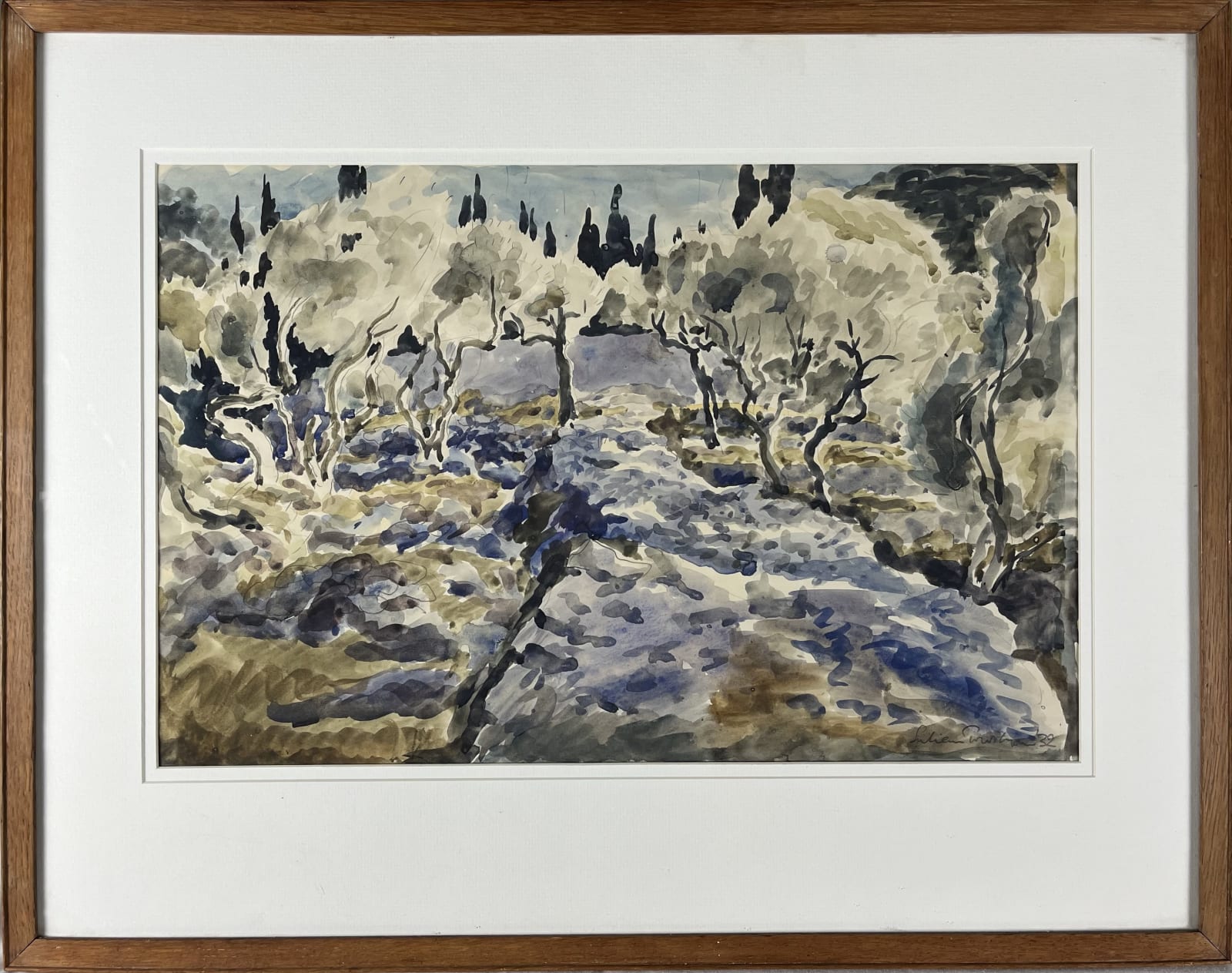


Julian Trevelyan RA (1910-1988)
Olivetum, Italy, 1932
Watercolour over pencil
13 1/2 x 21 1/4 inches
£ 3,500.00
Julian Trevelyan (Dorking, 1910-1988) was a British artist. Son of the eminent literary scholar Robert Trevelyan, Julian grew up surrounded by art, literature, politics, and the meeting of minds: his...
Julian Trevelyan (Dorking, 1910-1988) was a British artist. Son of the eminent literary scholar Robert Trevelyan, Julian grew up surrounded by art, literature, politics, and the meeting of minds: his father's friends often gathered and conversed at Shiffolds, the Trevelyan family home. Familiar faces included Bertrand Russell, Lytton Strachey, and the art historian Bernard Berenson, whose Italian house, Il Tatti Julian visited in his early twenties.
Through his life, Julian Trevelyan continued to live in discursive circles. He was a gregarious character whose encounters with a variety of cultural and political thinkers both informed his own works and turned him into an original figure of artistic inspiration for others. Trevelyan worked in a variety of media: painting, sketching, etching, lithographs, and even sculpture. His subject matters encompassed daily objects and scenes, from landscapes to personal domestic life and industrialisation. Stylistically, Trevelyan engaged with the early twentieth-century Modernisms of Expressionism and Surrealism. He was exposed to these through his encounters with other artists: from his formative art teacher at Bedales School, Gigi Meo, to his studio-cum-salon life in Paris where, having renounced his English Literature degree at Trinity College Cambridge in 1931, Trevelyan spent three years in the company of Alexander Calder, André Masson, Joan Miro and Pablo Picasso. Meeting these figures in Montparnasse's cafés and Stanley William (‘Bill') Hayter's experimental art studio known as Atelier 17, conversations effervesced with modern ideas of art, poetry, and politics. These inspired Trevelyan, yet he never lost his own artistic voice. By the age of just twenty-eight, Trevelyan devoted himself what it takes most artists a lifetime to negotiate: painting his own pictures without trying to please anyone but himself.
Following his marriage to the potter Ursula Darwin in 1934, Trevelyan became a London based artist, though continuing to travel widely and frequently through Europe. During the Second World War, Trevelyan served in the Royal Engineers from 1940 and was posted in North Africa and Palestine in 1942. He was appointed as Camouflage Officer, and with fellow artist and Surrealist advocate, Roland Penrose, Trevelyan developed Desert Camouflage. From the 1950s, the artist taught at the Chelsea School of Art and the Royal College of Art, London.
Olive Groves (1932) testifies the rich life Trevelyan had experienced just by the age of twenty-two. This watercolour demonstrates his travels: a distinctly European scene of gnarled ancient olive trees rendered in blue watercolour tones evoking the dappled pools of cool shade this scene offered the heat-weary traveller. However, there is also something fantastical about Olive Groves. The colours are fanciful: trunks and rocks twist into each other, reaching up into translucent and blustery foliage. Tall, dark cypress trees loom in the background. This tension suggests the painterly ‘schizophrenia' which Trevelyan identified in his works, split between his ‘Jekylls' (representational watercolour and gouache landscapes) and his ‘Hydes' (Romantic-Surrealist oils and etchings).Decades later, Trevelyan self-congratulated his successful blending of these apparently opposing styles. Yet Olive Groves anticipates this fusion as early as 1932: it is produced in the media of his ‘Jekylls', yet rendered in the dream-like quality of his ‘Hydes'. Olive Groves is a hugely important artwork, both for studies of Trevelyan, and of twentieth centuryBritish Art History.
Julian Trevelyan, Olive Groves, 1932, 35 x 54 cm, watercolour over pencil on paper, signed and dated bottom right. Contact for enquires.
Join our mailing list
* denotes required fields
We will process the personal data you have supplied in accordance with our privacy policy (available on request). You can unsubscribe or change your preferences at any time by clicking the link in our emails.

